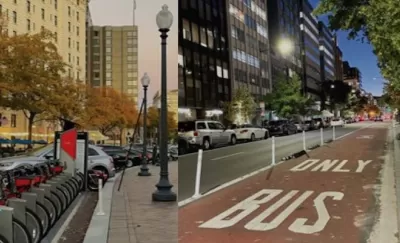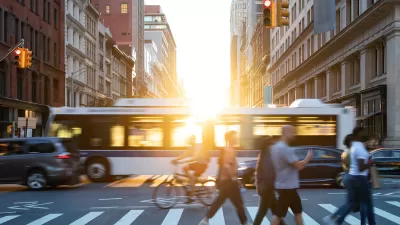Motor vehicle travel benefits users but also imposes large economic, social, and environmental costs. With better planning, our needs can be met with less vehicle travel. A new ITE report describes why and how to optimize the amount we drive.

Motor vehicle travel provides many benefits, but also imposes large economic, social and economic costs. A new Institute of Transportation Engineers report, Vehicle-Miles Traveled (VMT) as a Metric for Sustainability, can help guide planning to optimize the amount people drive.
This is an important and timely issue. Per capita vehicle-miles traveled (VMT) grew steadily during the Twentieth Century. During the growth period, transportation agencies applied “predict and provide” planning practices that contributed to a self-reinforcing cycle of expanded roads, more parking subsidies, reduced non-auto travel options, and sprawled development patterns that created automobile-dependent communities where it is difficult to get around without a car.
Per capita motor vehicle travel peaked about 2005, and current demographic and economic trends (aging population, rising vehicle costs, changing consumer preferences, increased health and environmental concerns) are increasing non-auto travel demands. In response, many transportation agencies are shifting from mobility-oriented planning, which assumed that our goal is to maximize travel speed and distance, to accessibility-oriented planning, which recognizes the ultimate goal of transportation is to provide access to services and activities, and policies intended to increase mobility often reduce accessibility in other ways.
To achieve sustainability goals, many jurisdictions are now reforming their planning practices to support accessibility-based planning. Some have established vehicle travel reduction targets to help guide these reforms. These policies can be justified for several reasons: to support more multimodal planning, to reduce traffic congestion, to reduce road and parking infrastructure costs, to reduce pollution emissions, and to improve community livability, public fitness and health.
This report discusses how much vehicle travel can be reduced, appropriate analysis methods and planning practices, and effective VMT reduction strategies. It also includes case studies from locations that optimized vehicle travel in the United States and internationally.
FULL STORY: VMT as a Metric for Sustainability

Alabama: Trump Terminates Settlements for Black Communities Harmed By Raw Sewage
Trump deemed the landmark civil rights agreement “illegal DEI and environmental justice policy.”

Study: Maui’s Plan to Convert Vacation Rentals to Long-Term Housing Could Cause Nearly $1 Billion Economic Loss
The plan would reduce visitor accommodation by 25% resulting in 1,900 jobs lost.

Planetizen Federal Action Tracker
A weekly monitor of how Trump’s orders and actions are impacting planners and planning in America.

Wind Energy on the Rise Despite Federal Policy Reversal
The Trump administration is revoking federal support for renewable energy, but demand for new projects continues unabated.

Passengers Flock to Caltrain After Electrification
The new electric trains are running faster and more reliably, leading to strong ridership growth on the Bay Area rail system.

Texas Churches Rally Behind ‘Yes in God’s Back Yard’ Legislation
Religious leaders want the state to reduce zoning regulations to streamline leasing church-owned land to housing developers.
Urban Design for Planners 1: Software Tools
This six-course series explores essential urban design concepts using open source software and equips planners with the tools they need to participate fully in the urban design process.
Planning for Universal Design
Learn the tools for implementing Universal Design in planning regulations.
Caltrans
Smith Gee Studio
Institute for Housing and Urban Development Studies (IHS)
City of Grandview
Harvard GSD Executive Education
Toledo-Lucas County Plan Commissions
Salt Lake City
NYU Wagner Graduate School of Public Service





























